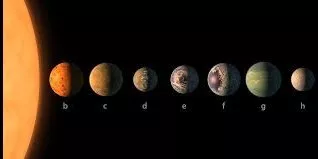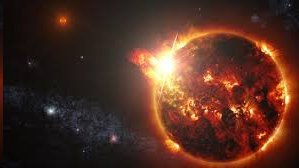View Other Topics.
 Mar 16, 2017
Mar 16, 2017
According to AOLnews.com, seven Earth-sized planets have been discovered orbiting a nearby star, three of which appear to be warm enough to sustain life, according to astronomers from NASA and the European Southern Observatory.
The newly discovered exo-planets are 40 light-years away and may contain liquid water.
A Belgian-led team made the discovery using both space- and ground-based telescopes, spotting the planets as they passed in front of the red dwarf star known as TRAPPIST-1.

TRAPPIST-1 is a small red dwarf star some 39 light years away-NASA
"This discovery gives us a hint that finding a second earth is not a matter of if but when," said Thomas Zurbuchen, Assoc. Admin., Science Mission Director at NASA.
The new findings were published in a study on Wednesday in the journal Nature, and were also announced during a news conference at NASA Headquarters in Washington.
"This is the first time that so many planets of this kind are found around the same star," continued Zurbuchen.
Zurbuchen called the discovery crucial in inching science closer to answering the question "are we alone out there?"
"What we really have in this story is a major step forward toward answering one of these very questions that are at the heart of so many of our philosophers... basically are we alone out there?"
"We are making a leap forward, in fact, toward answering that question."
Thousands of planets outside of our solar system, known as exo-planets, have been found in recent years, but few have existed in conditions that scientists predict could foster life.
Last year, astronomers discovered an Earth-like planet orbiting Proxima Centauri, the next closest star to our own solar system, which rests about four light-years away.
Lead author of new study Michaël Gillon described the TRAPPIST planetary system as "amazing" and not "only because we found so many planets but because they are all surprisingly similar in size to Earth."
All seven of the newly found planets are closer to their star than Mercury is to our sun. In our solar system, that would make the planets too hot to host liquid water -- considered one of the fundamental building blocks for life at this point.
But TRAPPIST-1 is a red dwarf, which makes it much cooler than our sun.
"TRAPPIST-1 is much cooler and much smaller than our Sun, and so the planets in its habitable zone are much closer to it," said Gillon.
Scientists also suspect the planets may be tidally-locked to the star, which would mean the same side of the planet faces its sun at all times, just like the same side of the moon permanently faces Earth. For the planets, this condition would mean one side of the planet is permanently light while the other permanently dark. It would also likely mean a significant temperate variation from one side to the other.
The next big question scientists hope to answer is whether or not the exo-planets have atmosphere.
"NASA's Hubble Space Telescope has initiated the screening of four of the planets, including the three inside the habitable zone," according to a NASA press release. "These observations aim at assessing the presence of puffy, hydrogen-dominated atmospheres, typical for gaseous worlds like Neptune, around these planets."
Tags:
#new#earth-#like#planets,#nasa#,#hubble#telescope,#astrology,#trappist-1,#starzpsychics.com,#starz#advisors
New Earth-like Planets Discovered.

According to AOLnews.com, seven Earth-sized planets have been discovered orbiting a nearby star, three of which appear to be warm enough to sustain life, according to astronomers from NASA and the European Southern Observatory.
The newly discovered exo-planets are 40 light-years away and may contain liquid water.
A Belgian-led team made the discovery using both space- and ground-based telescopes, spotting the planets as they passed in front of the red dwarf star known as TRAPPIST-1.

TRAPPIST-1 is a small red dwarf star some 39 light years away-NASA
"This discovery gives us a hint that finding a second earth is not a matter of if but when," said Thomas Zurbuchen, Assoc. Admin., Science Mission Director at NASA.
The new findings were published in a study on Wednesday in the journal Nature, and were also announced during a news conference at NASA Headquarters in Washington.
"This is the first time that so many planets of this kind are found around the same star," continued Zurbuchen.
Zurbuchen called the discovery crucial in inching science closer to answering the question "are we alone out there?"
"What we really have in this story is a major step forward toward answering one of these very questions that are at the heart of so many of our philosophers... basically are we alone out there?"
"We are making a leap forward, in fact, toward answering that question."
Thousands of planets outside of our solar system, known as exo-planets, have been found in recent years, but few have existed in conditions that scientists predict could foster life.
Last year, astronomers discovered an Earth-like planet orbiting Proxima Centauri, the next closest star to our own solar system, which rests about four light-years away.
Lead author of new study Michaël Gillon described the TRAPPIST planetary system as "amazing" and not "only because we found so many planets but because they are all surprisingly similar in size to Earth."
All seven of the newly found planets are closer to their star than Mercury is to our sun. In our solar system, that would make the planets too hot to host liquid water -- considered one of the fundamental building blocks for life at this point.
But TRAPPIST-1 is a red dwarf, which makes it much cooler than our sun.
"TRAPPIST-1 is much cooler and much smaller than our Sun, and so the planets in its habitable zone are much closer to it," said Gillon.
Scientists also suspect the planets may be tidally-locked to the star, which would mean the same side of the planet faces its sun at all times, just like the same side of the moon permanently faces Earth. For the planets, this condition would mean one side of the planet is permanently light while the other permanently dark. It would also likely mean a significant temperate variation from one side to the other.
The next big question scientists hope to answer is whether or not the exo-planets have atmosphere.
"NASA's Hubble Space Telescope has initiated the screening of four of the planets, including the three inside the habitable zone," according to a NASA press release. "These observations aim at assessing the presence of puffy, hydrogen-dominated atmospheres, typical for gaseous worlds like Neptune, around these planets."
Share this article with friends!
Tags:
#new#earth-#like#planets,#nasa#,#hubble#telescope,#astrology,#trappist-1,#starzpsychics.com,#starz#advisors






